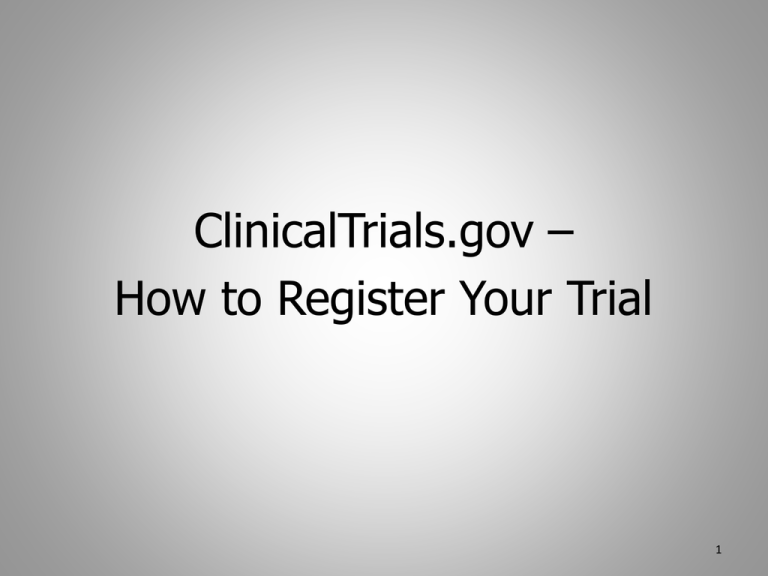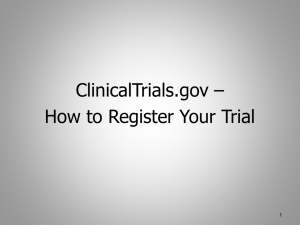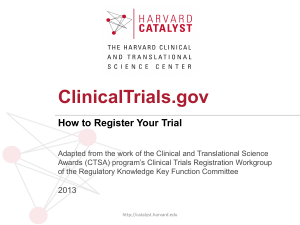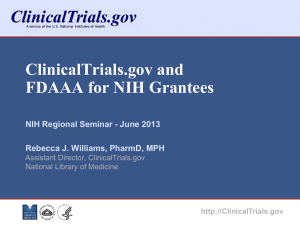Overview of Clinicaltrials.gov (Benefits & Burdens?)
advertisement

ClinicalTrials.gov – How to Register Your Trial 1 ClinicalTrials.gov • Operated by the National Library of Medicine (NLM) • Your CTSA organization has an institutional account o Individual investigators/employees are given user profiles on that account • Each study gets only one record, regardless of number of sites • Each study should be registered by the Responsible Party (RP) • Each institutional account can have many records/studies o Each user can have access many records/studies under his/her profile o While users can edit such records, only the RP can release it • Type of information in ClinicalTrials.gov o Registration o Results Adverse Events 2 ClinicalTrials.gov – Registration Information • Description of study o Study type, Phase, Design, Outcome measures • Recruitment information o Eligibility criteria, locations, recruitment status • Administrative and other information o Key dates and contact information • Helpful links to add o MEDLINE publications, consumer health information, FDA information 3 New User Access to ClinicalTrials.gov • Provide the following information to your PRS Administrator: o Desired user name o Full name (e.g., John J Smith, MD) o Email address • PRS Administrator sends profile request to ClinicalTrials.gov • ClinicalTrials.gov emails Investigator/staff notifying of account & provides temporary password (within 2 days) • You may now log into the ClinicalTrials.gov Protocol Registration System: https://register.clinicaltrials.gov/ 4 Responsibilities of an Owner of Study Records on ClinicalTrials.gov….. • • • You are responsible for maintaining the study records associated with your account. When you enter information about the study, please ensure the information is correct, readily understood by the public, and updated in a timely manner. Only one owner can be assigned to a study record, but the owner can also allow other users to edit the study record. Use the Access List. 5 ClinicalTrials.gov Login Page Log in: https://register.clinicaltrials.gov/ Organization Name = Your CTSA Organization 6 ClinicalTrials.gov Menu After log in: Blue Menu box is what everyone sees. Check out the Help on the Blue Menu. To Create a new protocol record, Click on “Create” 7 Registration in Create/Modify View 8 Board Approval Pfizer Pfizer Pfizer Pfizer Pfizer Pfizer 9 Responsible Party versus Owner Anyone can be the owner of a study. Owners are often Study Coordinators or study team members, and assist the Responsible Party with data entry. The Responsible Party (RP) is legally responsible for registering their study record on ClinicalTrials.gov, ensuring accuracy, and making sure that the content is up-to-date. An RP must “Approve” and “Release” a study record onto ClinicalTrials.gov. • Identification of RP o Sponsor – Organization that initiates the study or o Principal Investigator (PI) –Only if designated as the RP by the Sponsor Organization or o Sponsor-Investigator – Individual who both initiates and conducts Owners and RP must be Protocol Registration System (PRS) users of the organizational account. 10 Responsible Party Designation 11 Tips: • Brief Title and Summary should be in lay language • Overall Recruiting Status and Recruiting Status in the locations must match • Dates are needed for Study Start Date, and Primary and Study Completion Dates • Change the Verification Date to the current month and year (this updates the record) 12 Entering the Study Type Observational: Studies in human beings in which biomedical and/or health outcomes are assessed in pre-defined groups of individuals. Subjects in the study may receive diagnostic, therapeutic, or other interventions, but the investigator does not assign specific interventions to the subjects of the study. Interventional: Studies in human beings in which individuals are assigned based on a protocol to receive specific interventions. Subjects may receive diagnostic, therapeutic or other types of interventions. The assignment of the intervention may or may not be random. The individuals are then followed and biomedical and/or health outcomes are assessed. Hints: • Randomized studies are interventional. • Studies with investigational drugs or devices are likely to be interventional. Definitions above are from ClinicalTrials.gov Protocol Data Element Definitions: https://register.clinicaltrials.gov/prs/html/definitions.html 13 How to Enter Outcome Measures Outcome measure information: Please be as specific as possible. • • • • Title: include the name of the specific measure. Avoid using verbs, that is, do not put “To determine…” Time Frame: must have a time point at which the outcome is assessed for the specific metric used (hours, days, weeks, years) Hint: specify which study day it is measured - do not use “until the end of study or death.” Description: describes what will be measured, not why it is measured. If the outcome measure is a questionnaire or scale, provide the range and what low or high scores mean. Safety Issue: Is this outcome measure assessing a safety issue? 14 Example of Problematic Primary Outcome Measure 15 Example of Corrected Primary Outcome Measure* * Secondary Outcome Measure fields require same information 16 How to Enter Arms/Interventions Information 17 Central Contact/Location Info Central Contact: • Please list the person providing centralized coordinated recruitment information. Locations: • Please list all sites if the study is multi center. • Recruitment Status should match the Overall Recruiting Status above. Note: Please fill this section in completely. This information will give participants the correct information on whom to contact. 18 Completed all fields and Ready to Release your study on ClinicalTrials.gov Please ensure you have thoroughly reviewed your study record… • All fields should be completely filled out and in lay language (where possible) • All red errors must be corrected • Any misspelled words should be corrected • Acronyms and abbreviations should be spelled out 19 Next Action: Complete: The person updating or owner of the record will click on “Complete” to indicate that the study is ready for the “Approve” and “Release” actions. Approve and Release: The Responsible Party (Administrator, if Sponsor; PI, if Sponsor-Investigator or designated PI) of the study needs to click on “Approve” and “Release” for the study to go through Quality Assurance (QA) review and be published on ClinicalTrials.gov website. 20 ClinicalTrials.gov QA ClinicalTrials.gov does a manual review • • • • If there are QA issues, the record owner and RP will receive notification from ClinicalTrials.gov with comments. The study will be reset to “In Progress”. Study Owner/RP will corrected the issues and re-release it. If there are no QA issues, the study is assigned an NCT number and published on the “public” side of the database. This process takes about 2-5 business days. 21 Published Registration 22 Summary of Registration Process • • Fill out Registration (“Create” a record) Actions: o In progress: Fields to be completed o Completed: Ready for Approval and Release o Approved/Released: o • • • RP is sole party that can “Approve & Release ClinicalTrials.gov QA NCT number assigned Posted on ClinicalTrials.gov 2-5 business days 23 Ongoing Responsibilities of an Owner of Study Records on ClinicalTrials.gov….. • • • • Records can be transferred to other user accounts as staff change. Records must be updated every 6 months – unless Overall Recruitment Status changes, then you should update the record within 30 days. Records must be updated within 30 days after the completion date. Failure to update information on ClinicalTrials.gov can result in penalties 24 Updating Your Record • • • • • • • Log into ClinicalTrials.gov Click on “Modify” Click on “Edit” to open the study. Make appropriate changes by clicking on “Edit” along the side in the study record. If no changes have occurred in the last 6 months, update the Record Verification Date by clicking the “Edit” button next to the field. Be sure click on “Complete” when finished updating. Study is ready for “Approval” and “Release” Know who is responsible for “Approval” and “Release” 25 General Tips on Updating Your Record • Complete all fields • Use spelling tool for spelling errors • Spell out acronyms and abbreviations • Use the EDIT links to make changes or “Edit All” link at top • Check for errors and warnings • Check for notes (optional to address) 26 26 Can a study record be deleted off of ClinicalTrials.gov? • Only if the study record has never been published on ClinicalTrials.gov • Otherwise, No. • ClinicalTrials.gov serves as a long-term public registry. Once a study record is published, it remains in the system even after a trial has closed. • If you find a duplicate, contact ClinicalTrials.gov at register@clinicaltrials.gov. 27 27 Checking your Problem Records PRS System identifies current ‘Problem Records’ • • • • Records that have not been marked as completed Active studies that have not been updated in the past 6 months Records missing one or more data elements required by FDAAA, such as: Responsible Party, Study Start Date, Primary Completion Date and Primary Outcome Measure Records that appear to be overdue for registration of results per FDAAA 28 ClinicalTrials.gov - Help 29 Additional Resources • • • • • • • General ClinicalTrials.gov information: http://clinicaltrials.gov/ct2/about-site FDAAA related information: http://clinicaltrials.gov/ct2/manage-recs/fdaaa For specific questions or comments: register@clinicaltrials.gov. Office of Extramural Research (OER): http://grants.nih.gov/Clinicaltrials_fdaaa/ Frequently Asked Questions for NIH Grantees: http://grants.nih.gov/Clinicaltrials_fdaaa/faq.htm Instructions for Authors sections of ICMJE journals all have information regarding clinical trial registration Local Contacts: • ADD “YOUR U” contacts here or on a final slide 30 This slide set was made possible by a collaboration of CTSA organizations (Mayo Clinic, Partners, University of Michigan Medical School, University of Rochester) and the National Library of Medicine. The Clinical and Translational Science Awards Program (CTSA) is part of the Roadmap Initiative, Re-Engineering the Clinical Research Enterprise and is funded by the National Center for Advancing Translational Sciences (NCATS), National Institutes of Health (NIH). 31








